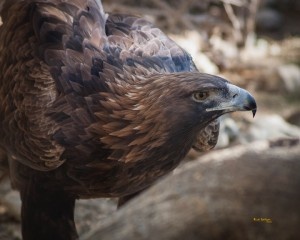 The chase is on! A Raven swoops while the Eagle dodges just out of reach. The Eagle pulls forward and is gaining yardage quickly. Another Raven cuts across, pushing the Eagle towards the edge. They are neck in neck, the Eagle dives…TOUCHDOWN!
The chase is on! A Raven swoops while the Eagle dodges just out of reach. The Eagle pulls forward and is gaining yardage quickly. Another Raven cuts across, pushing the Eagle towards the edge. They are neck in neck, the Eagle dives…TOUCHDOWN!
In nature, we often see smaller birds following and pestering larger birds. I have seen ravens chasing after an eagle, and not just the ones on TV on Sunday afternoons. Many of our NFL teams are named after animals found in nature. Some teams are represented by ferocious predators, like the Lions, Jaguars, Panthers, Dolphins, Falcons, Eagles and Bears. Compared to some of these, animals like the Cardinals, Colts, Rams, Ravens, and even Colorado’s beloved Broncos, seem like rather un-intimidating mascots. When you really think about it though, from the perspective of nature, in most game day matchups, there would almost always be a predictable winner.
The majority of teams with animal-based mascots can be divided into three distinct categories. We have the feline teams, the ungulate teams, and the bird teams. Ungulates are mammals that walk on the tips of their toes and therefore develop a very think toenail, or a hoof. The Rams, Colts, and Broncos make up the NFL’s ungulate teams. All three of these animals are herbivores. Both colt and bronco are terms for horses. Horses can run fast, kick hard, but are generally a rather sedentary prey species. The term ram refers to a male bighorn sheep. A ram’s biggest claim to fame is the large curved horns they carry on their heads. Rams use their horns to spar against others to establish dominance and access to ewes during mating season. The skull of the bighorn sheep is specially adapted to withstand the heavy impacts of ongoing head-to-head collisions. Perhaps our NFL heroes would benefit from this adaptation as well? Bighorn sheep, though stocky in build, are both graceful and agile as they climb across nearly sheer cliff faces. Although head-butting and kicking other players are not allowed on the football field, the bronco’s speed and the ram’s agility are both features that a good football team might recruit for.
Lions, Jaguars, and Panthers can all be categorized as feline football teams. Lion, panther, cougar, catamount, and puma are all regional terms for the mountain lion. Mountain lions and jaguars are the largest members of the cat family in North America. Locally, mountain lion primarily eat deer, but will also prey on livestock if the opportunity presents itself. Like house cats, these animals stalk their prey and then pounce. A bite to the back of the neck from these felines can be fatal. However, I’m not sure if stalking and pouncing is a great strategy in the game of football, but their ability to run very quickly in bursts of speeds would be a benefit to the team on the field.
Finally, many NFL teams are named after birds. Falcons, Cardinals, Ravens, and Eagles are all football teams with the power of flight. Seahawk refers to a fish eating bird known locally as an osprey. While encountering an osprey, an eagle, or a falcon might be a scary experience if you were a rodent, fish, or small bird; their talons and sharp beaks are not features that would be especially beneficial in the game of football. Ravens scavenge for their food, but are highly intelligent and are known to be tricksters. The ravens could bring a unique level of strategy and cunningness to the game. The least intimidating of all the NFL birds is the cardinal. Cardinals are seed eating birds and probably would not stand a chance against any of the other animals species found in football. Overall, if football players had the ability to fly, that could add an additional level of challenge and greater intrigue to the game.
No matter how you match them up, some game pairings from the animal kingdom might make for a rather unrealistic match. For example, what would happen if you matched the Colts versus the Dolphins? Should the game be played on land or in the water? At what point is the home-field advantage too great? On the other hand, I think the most realistic games might be Lions versus the Panthers, at least it would be a fair match within the same species.
This season, while you are watching your favorite team battle it out on the gridiron against their biggest competitor, take a moment to close your eyes and listen to the commentary. What would this match up look like if the players were members of the animal kingdom? Chances are the Cardinals wouldn’t stand a chance against the Jaguars.









